The Saga of the
SUBMARINE
IN THE NUCLEAR AGE
World's First True Submarines
The following artical is reprinted from the September 1967 issue of ALL HANDS Magazine.
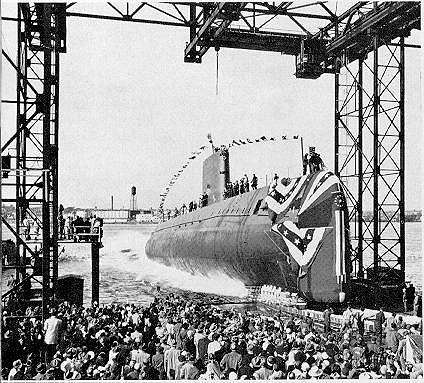
The USS Nautilus SSN 571 slides down
the ways into history.
Jan. 21, 1954
0n17 Jan 1955, approximately 200 diesel powered submarines were in commission in
the U. S. Navy.
On that day they became obsolete, as did all the other submarines in the world.
That was the day when the hull SSN 571 (later to he known to the world as
USS Nautilus), the first nuclear powered submarine, put to sea for the first
time. That was the day that then-Commander Engene P. Wilkinson, commanding officer,
sent the message which was to change permanently the concept of seapower:
“Underway on nuclear power."
Before Nautilus became a reality, a submarine was
more or less a small surface ship that could submerge for short periods of time.
In 1955, the submergence time and the average submerged speed of a submarine had
not greatly changed from those of submarines in operation .‘30 years earlier.
The trouble was, diesels needed oxygen to operate. So did crewmembers. When submerged,
that oxygen supply was cut off. The boat depended for its power on electric batteries;
the men depended upon the air trapped within the hull or carried in bottles and
chemicals. The whole concept was limited by one of the basic facts of life – men
and machines must breathe to live.
A NUCLEAR SUB was different. Its nuclear reactor eliminated the diesel engines
which had limited a sub’s range and speed; had eliminated the need for diesel
fuel and resultant storage spaces; had eliminated the need to surface periodically
to recharge batteries.
The power plant of a nuclear submarine is based upon a nuclear reactor which provides
heat for the generation of steam. This, in turn, drives the main propulsion turbines
the ship’s turbo-generators for electric power.
The primary system is a circulating water cycle and consists of the reactor, loops
of piping, coolant pumps and steam generators. Heat produced in the reactor by
nuclear fission is transferred to the circulating primary coolant water which is
pressurized to prevent boiling. This water is then pumped through the steam generator ,
and back into the reactor for reheating in the next cycle.
From the steam generators, steam flows to the engine room where it drives the
turbo-generators, which supply the ship with electricity, and to the main propulsion
turbines, which drive the propeller. After passing through the turbines, the steam
is condensed and the water is feel back to the steam generators by the feed pumps.
In the steam generator, the heat of the pressurized water is transferred to a
secondary system to boil water into steam. This secondary system is isolated from
the primary system.
None of these steps require the presence of air or oxygen. Thus, any ship so powered
is able to operate completely independent of the earth’s atmosphere for long periods.
During the operation of the nuclear power plant, high levels of radiation exist around
the reactor, and members of the crew are not permitted to enter the reactor compartment.
Heavy shielding protects the crew so that a man receives less radiation on submerged
patrol than he would from natural sources ashore.
1960, 14 nuclear powered submarines were commissioned, demonstrating that production
was rolling, only a few years after the pioneering work that had
brought about the world’s first nuclear ship, USS Nautilus. Here’s the background:
At the request of then-Captain (now VADM) H. G. Rickover, USN, the first study of
the application of a high-pressure, water-cooled reactor for a submarine was
undertaken at Oak Ridge, Tenn., in September 1947. In January 1948 the Department
of Defense requested the Atomic Energy Commission to design, develop and build a
nuclear reactor which would propel a submarine.
In August 1949 the Chief of Naval Operations established an operational requirement
to develop a submarine nuclear propulsion plant with a ready-for-sea date of January
1955. The late Admiral Forrest P. Sherman, then CNO, recommended the construction
of a nuclear submarine to Congress on 25 Apr. 1950, and the following August, the
President signed Public Law 674
which authorized construction of Nautilus.
That same month saw the start of construction of the Nautilus land-based prototype
(submarine thermal reactor, Mark I) at the AEC’s National Reactor Testing
Station in Idaho. Mark I (Nautilus was known as STR
Mark II) was built from the start inside a submarine hull, complete with a
surrounding tank of water, on the assumption that it was a true seagoing power
plant. Breadboard techniques and engineering shortcuts were riot allowed.
The model went critical at 11:17 PM, MST on 30 Mar 1953 – an occasion which marked
the first production of significant quantities of useful nuclear power in the world.
About three months later, on 25 June, Mark I commenced a 96-hour sustained full-power
run, simulating a submerged crossing of the Atlantic.
Meanwhile, in August 1951, the Bureau of Ships (now the Naval Ship Systems Command)
awarded
contract for the construction of the first nuclear powered submarine. From this
point onward, events
moved rapidly. Nautilus’ keel was laid 14 Jun. 1952 at Groton. She was
christened on 21 Jan 1954 and was commissioned
'30 Sept 1954. Her nuclear power propulsion plant was first operated at power on
20 December and first developed full power alongside the dock on 3 Jan 1955. A
s mentioned earlier, it was on 17 Jan 1955 that Nautilus, putting to sea for the
first time, signaled her message: “Underway on nuclear power.” Her Mark II
reactor, a refined version of the prototype Mark I reactor, behaved beautifully.
During her first sea trials, she completed high speed test runs, both surfaced and
submerged, and dived more than 50 times. After further testing, she was accepted
by the Navy on 22 Apr. 1955.
SHE THEN PROCEEDED to smash just about every existing record that pertained to subs.
On her shakedown cruise in May, Nautilus steamed submerged from New London,
Conn., to San Juan,
Puerto Rico, traveling over 1300 miles in 84 hours – more than 10 times further than
any submarine had ever
traveled while submerged. It was the first time that a combatant submarine had
maintained such a high submerged speed (about 16 knots) for longer than an hour,
the longest period spent
submerged by a U. S. submarine, and the fastest passage between New London and San
Juan by any submarine,
surfaced or submerged, She later made an even faster submerged passage from Key
West to New London, a distance of 1397 miles, at an average speed of more than 20
knots. After more than two years of operation and evaluation, nautilus was refueled
in April 1957. On her first core she had steamed a total of 62,562 miles, more than
half of which was submerged. To cover this distance, a
conventionally powered sub the size of Nautilus would have required more than two
million gallons of fuel oil. She then resumed operations with the Fleet, deploying
to the Pacific via the Panama Canal and, upon her return to the Atlantic, participating
in NATO exercises in Northern European waters. She completed several excursions
under the polar ice cap and penetrated to within 180 miles of the North Pole.
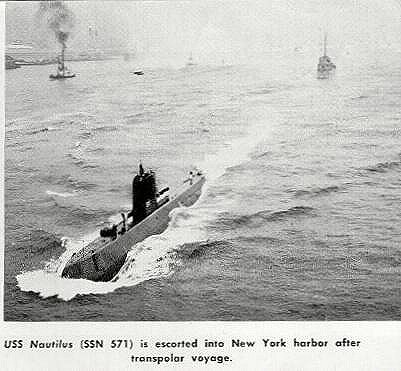
This was merely prelude. On 12 Aug. 1958, she completed a trans-polar voyage from
Pearl Harbor to Portland, England. After diving under the ice near Point Barrow,
Alaska, on 1 August, she became the first ship to reach the geographic North Pole,
passing beneath it on 3 August. She surfaced in the Greenland Sea two days later
after steaming 1830 miles under the ice in 96 hours.
For this achievement, which demonstrated the strategic potential of the Arctic, she
was awarded the Presidential Unit Citation (the first such to be awarded in peacetime)
and her commanding officer, Commander William R. Anderson, the Legion of Merit.
In May 1959, she was again refueled and received her first regular overhaul –
after more than four years of intensive operation. She had steamed more than 153,000
miles on her first two reactor cores, 115,000 miles of which had been submerged.
During her first four and one-half years of operation, she had been submerged for
more than one year.
By September 1966 she had completed 300,000 miles of steaming on nuclear power, more
than 250,000 of which were submerged.
The reliability of Nautilus’ nuclear propulsion plant was considered to be due
in large measure to the
experience gained in the construction and operation of the land prototype plant. After
being refueled in late 1955 following two years of nearly continuous operation and
testing, the prototype completed a continuous full power run of 66 days with its new
core installed. This would have been sufficient to carry Nautilus twice around
the world without refueling, and served to demonstrate the virtually unlimited cruising
range of nuclear powered hips, even at high speeds. The prototype again refueled in early
1958 and late 1960 and now being refueled with an advanced design core, is used
today as a test facility for investigating new concepts in the technology, design
and operation of advanced nuclear power plants as well as a training facility for
crewmembers of nuclear powered ships.
Preliminary development work had involved the investigation of many concepts. Of
these, only two –
the pressurized water and the liquid metal (sodium) – were of sufficient interest
from a naval standpoint to warrant a prototype and shipboard installation. The
pressurized water concept was first applied to Nautilus; the liquid sodium
concept to the Navy’s second nuclear powered sub – Seawolf
.
As with Nautilus, the development of the Seawolf liquid sodium plant
involved the construction of a
land prototype" plant. Known as the Submarine Intermediate Reactor, this was built
at the Knolls Atomic Power Laboratory at West Milton, N. Y. Seawolf’.s keel
was laid 15 Sep 1953, and she was
launched 21 Jul 1955. However, trouble developed in her reactor and she was not
ready for her sea trials until January 1957. After acceptance, USS Seawolf (SSN 575)
operated as an active unit of the Atlantic Fleet and on 6 Oct. 1958, completed
record-breaking 60-day submerged run, traveling a distance of more than 13,000 miles
submerged with completely sealed atmosphere. Although she was able to operate
satisfactorily for almost two years on her sodium-cooled reactor, technical and
safety considerations indicated that the concept be dropped. In December 1958,
the sodium-cooled reactor was removed and was replaced with a pressurized water
plant similar to that in Nautilus. When she shut down her sodium plant for the
last time, she had steamed a total of 71,000 miles, of which 57,000 were submerged.
With her new pressurized water plant installed, Seawolf was recommissioned
on 30 Sep 1960. In May 1965, she was refueled for the first time since the installation
of her pressurized water reactor. On this core she had steamed more than 160,000
miles, of which more than 130,000 were submerged.

USS TRITON ( SSN 586) was designed to be fast enough to operate with a fast
carrier task force.One of the largest submarines ever built, Triton is 447
feet long, displaces more than 7700 tons submerged, and carries a crew of approximately
170. Her keel was hid 29 May 1956, she was launched 19 Aug. 1958, and was commissioned
10 Nov. 1959. She has two pressurized water reactors, one for each of her two propellers.
On 16 Feb. 1960, she departed New London on a submerged circumnavigation of the
world. Following the same route taken by Ferdinand Magellan in 1519, Triton
proceeded to St. Peter and St. Paul’s Rocks in the Atlantic and crossed the equator
on 24 February. Two weeks later she rounded Cape Horn and entered the Pacific Ocean.
From there, she sailed to Magellan Bay in the Philippines, thence south through
Lombok Strait and rounded the Cape of Good Hope. She again reached St. Peter and
St. Paul’s Rocks on 25 April and proceeded via the Canary Islands and Cadiz, Spain, to
the United States. Surfacing off the coast of Delaware on 10 May, she had traveled
'36,000 miles completely submerged in 83 days and 10 hours. For this voyage, she
received the Presidential Unit Citation and her commanding officer, Captain Edward L. Beach,
was awarded the Legion of Merit. She has since been refueled once, and now
operates with the Fleet as an attack submarine.
The need for a nuclear propulsion plant similar to that of Nautilus but
smaller, suitable for smaller subs, soon became apparent. Bettis Atomic Power
Lab was given the assignment.
This plant, know as the Submarine Fleet Reactor uses pressurized water reactor
similar to that used in Nautilus, hut is much simpler and contains several
improvements in operation and maintenance.
Five subs – Skate (SSN 578), Swordfish (SSN 579), Sargo (SSN 583),
Seadragon (SSN 584) and Halibut (SSN 587) – are powered by this type
plant. The first four of this class are attack subs; Halibut is the first
Navy submarine to be designed from the keel up as a guided missile submarine.
Skate was commissioned 23 Dec. 1957. On 24 Feb. 1958, she departed New
London on her shakedown cruise and, eight days and 11 hours later, arrived at
Portland, England. Her 176-hour submerged transit of the Atlantic had set a
new west-east record. On her return trip, Skate surfaced off Block
Island seven days and five hours after departing Lizard Head, breaking still
another record. She was the first submarine to make the transatlantic voyages
to England and return while submerged. In August, Skate crossed under
the North Pole while exploring undersea routes beneath the polar ice cap.
During this trip, she spent 10 days and 14 hours and traveled slightly more
than 2400 miles under the ice.
She surfaced within the icepack nine times. One of these surfacings was near the
International Geophysical Year’s Floating Ice Station Alfa, where scientific
information was exchanged with the resident scientists.
With only a slight air of facetiousness, she claims to be the first submarine
to go around the world in one hour. She circumnavigated the North Pole on a
circular course within one mile of the pole.
In March 1959, she made another extensive trip under the polar ice cap – this time
in winter. During this trip, she traveled 11,495 miles, 11,220 of which were
submerged and more than 3000 under the polar ice cap. She broke through the polar
ice to surface on 10 occasions.
Slightly less than five years after her commissioning she entered the yards to
receive her first refueling and overhaul. She had steamed 120,862 miles, of which
105,683 were submerged, on her first core.
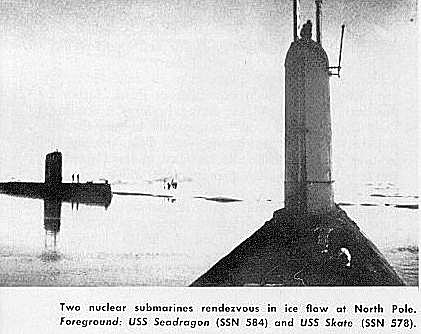
SWORDFISH was commissioned on 15 Sept. 1958, and Sargo followed with her
commissioning on 1 October.
Sargo also did extensive polar exploration. Sailing from Pearl Harbor,
she entered the Arctic Basin by way of the Bering and Chukchi Seas. Fitted with
a new ice-berg-detecting sonar, she proved that it is possible for a nuclear powered
submarine to cross this shallow route at any time of the year.
Numerous ice ridges, some extending as much as 100 feet deep, were encountered.
On many occasions, it was necessary for her to split the distance from the ice to
the ocean floor, clearing each by just a few feet.
She returned to the open Pacific through the Bering Sea. She had traveled 6000
miles in 31 days, and surfaced 20 times. Usually, it was necessary to break through
the ice before she could surface.
Assigned to the Pacific Fleet after her commissioning on 5 Dec. 1959, Seadragon
reached the Pacific via the Northwest Passage during August 1960. She remained in
the Arctic Basin during August and, on the 24th, became the fourth U. S. submarine
to reach the North Pole. Another, but less-than-monumental first was ,achieved –
the first baseball game held on the pack ice between the officers and enlisted
members of the crew.
Two years later, on 2 Aug. 1962, Skate and Seadragon rendezvoused
under the ice at the North Pole, conducted antisubmarine warfare exercises and
surfaced together at the Pole.
Design of a single screw nuclear propulsion plant suitable for installation in a
submarine of higher displacement and higher speed than Nautilus also was undertaken
by Bettis. Much of the experience gained from the Submarine Fleet Reactor was used
to incorporate improvements and advancements in this type of plant. It is now being
used extensively in both fast attack and Fleet ballistic missile class submarines.
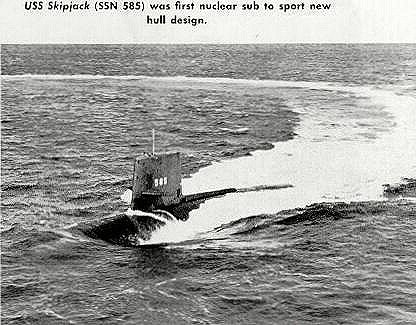
This type of plant, combined with the cylinder-of- revolution hull form developed
with USS Albacore (SS 560), resulted in the USS Skipjack (SSN 585)
class. Commissioned 15 Apr. 1950, Skipjack’s clean design enabled her to
break all existing submarine speed records. Most nuclear submarines built since
that time have been based upon the Skipjack concept.
While Nautilus was still undergoing operational testing, the Navy began
development of an intermediate range ballistic missile. Brought from conception
to operation in five years, the Polaris Fleet ballistic missile system was combined
with nuclear propulsion to produce a missile-firing submarine essential to the
United States’ deterrent concept.
Each Polaris submarine carries 16 solid-fuel, two-stage ballistic missiles powered
by solid fuel rocket motors, guided by a self-contained inertial guidance system,
providing a combined explosive power greater than the total of all the bombs
dropped by all aircraft alluring World War II. Nuclear propulsion enables these
sub' to remain on patrol, hidden beneath the surface of the sea, always ready to
launch their missiles.
On station, a Polaris sub maintains complete radio silence, receiving radio
messages hut sending none, lest it give away its location. Each ship has two
complete crews, the Blue and the Gold, of some 130 men each. The crews alternate
on two-month patrols, providing the greatest possible on-station time for the FBM submarines.
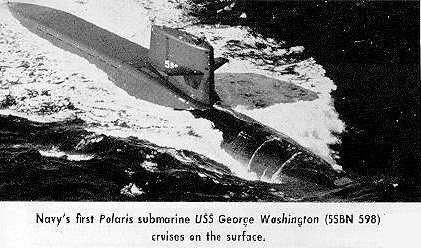
USS GEORGE WASHINGTON (SSBN 598) was the first ballistic missile submarine
to be built. Originally designed to be a Skipjack-class fast attack sub, her
partially constructed hull was cut and a 130-foot missile section added amidships.
Commissioned 30 Dec. 1959, she successfully test-fired two Polaris A-1 missiles
while submerged six months later. In November 1960, she departed for her first
armed Polaris missile patrol, remaining submerged for more than 66 days. After
deploying on 15 submerged patrols and steaming more than 100,000 miles, she was
ready for refueling and refitting for longer range missiles.
Four other FBM submarines, USS Patrick Henry (SSBN 599), Theodore Roosevelt
(SSBN 600), Robert E. Lee (SSBN 601) and Abraham Lincoln (SSBN 602)
are included in the George Washington class. Although originally
designed to carry the A-1 missile, all five were, in March 1967, being converted
to handle the A-3 missiles.
USS ETHAN ALLEN (SSBN 608) was the first ballistic missile submarine to be
designed from the keel up as an FBM submarine. This class, consisting of Ethan Allen,
Sam Houston (SSBN 609), Thomas A. Edison (SSBN 610), John Marshall
(SSBN 611), and Thomas Jefferson (SSBN 618) are 410 feet long, displace
6900 tons and can handle the A-1 (1200-mile) and A-2 (1500-mile) Polaris missiles.
On 23 Oct. 1961, Ethan Allen fired the first submarine-launched A-2 missile;
on 8 November she set a missile-firing record by successfully launching six out of
six Polaris A-2 missiles; and on 6 May 1962 she fired a Polaris in what was the
first complete test of a ballistic missile, including detonation of the nuclear
warhead.
The USS Lafayette (SSBN 616) class, third class of FBM submarines, is
approximately 425 feet long, and displaces approximately 7000 tons. These 31 ships
can accommodate the A-l, A-2 or A-3 missile.
On 28 Sept. 1964, a ship of this class, USS Daniel Webster (SSBN 626)
began her first deployment, carrying the first shipload of the A-‘3 missiles.
On 25 December, a sister ship, Daniel Boone (SSBN 629) departed her operational
base in Guam loaded with 16 A-3 missiles, marking the first operational deployment of
a Polaris missile submarine in the Pacific.
Will Rogers (SSBN 659) last of the 41 currently authorized FBM submarines
was launched 21 Jul. 1966, and completed her sea trials in February 1967. Will
Rogers marks the completion of the currently planned FBM shipbuilding program.
Where They Came From
An impressive roster.
All were made possible through the cooperation and hard work – and taxes – of thousands,
if not millions, of U.S. citizens, and through the foresight and planning of countless
organizations from Congress and the President on down.
However, a major role in the development of these nuclear craft has been assumed
by the Atomic Energy Commission and the Navy Department through the Naval Nuclear
Propulsion Program. Its objective has been the design and development of improved
naval nuclear propulsion plants for installation in ships ranging from small
submarines to large combatant surface ships.
The program is directed by VADM Hyman G. Rick-over, USN, Director, Division of
Naval Reactors, U. S. Atomic Energy Commission and Deputy Commander for Nuclear
Propulsion, Naval Ship Systems Command.
Design and development of these plants is carried out by AEC’s Bettis Atomic Power
Laboratory, Pittsburgh, Pa., and Knolls Atomic Power Laboratory, Schenectady, N. Y.
The program also operates and maintains six land prototype nuclear propulsion
plants. Two are located at West Milton, N. Y., one at Windsor, Conn., and three
at the Atomic Energy Commission’s National Reactor Testing Station, Idaho.
In addition to testing power plant designs, the land prototypes are used to train
the men – both officers and enlisted personnel – who operate the shipboard plants.
Approximately 2500 officers and 14,000 enlisted men have been trained at these
prototypes to date.
The nuclear power training program is divided into two phases. The first consists
of a 24-week course at the Nuclear Power School located either at Bainbridge or
Mare Island. This is followed by orders to one of the prototypes for six months.
Courses are on a college level for most enlisted men and on a graduate level for
officers.
CONGRESS HAS AUTHORIZED 107 nuclear powered submarines including 41 Polaris
missile-launching type and one deep submergence research vehicle and six nuclear
powered surface ships.
Of these, 70 nuclear powered submarines and four nuclear powered surface ships
are now in operation and have steamed over 9,150,000 miles. Not once has a mission
been aborted because of a failure in the reactor.
A total of 234 nuclear cores have been ordered to date, and 92 are in operation
today.(1967) The first core for Nautilus’ cost more than four million dollars and
enabled her to steam 62,000 miles. The second cost three million dollars on which
she steamed 91,000 miles.
The long-life cores now installed in nuclear submarines cost about three million
dollars and will propel the ship for about 400,000 miles.
Naval nuclear propulsion plant components, including the nuclear reactor and its
special instruments and controls, are obtained from private industry on a competitive
fixed-price basis. More than 500 industrial contractors – 150 large and 350 small
businesses – are engaged in the fabrication and supply of this equipment.
Five private shipyards and six naval shipyards are engaged in the construction or
overhaul of naval nuclear powered ships.
Shape of Ships to Come
Included in the Navy’s fiscal year 1967 shipbuilding and conversion program are
one nuclear powered attack carrier (CVAN), one nuclear powered guided missile
frigate (DLGN) and five nuclear powered attack submarines (SSN). Here’s a brief
description of each:
Nuclear Powered Attack Carrier (Project 102.67) – This ship will he nuclear
powered with the new two-reactor plant that has been under development in recent
years.
It will be the most modern warship in the world and will be an improved successor
to USS Enterprise (CVAN 65) which has performed so well in both peacetime and
wartime environments.
She will have a full Naval Tactical Data System and an Integrated Operational
Intelligence Center. Automation in areas of main propulsion, ordnance handling,
ship control and other areas will be included as possible wherever safety can be
improved and manning reduced.
Guided Missile Frigate (Nuclear) (Project 241.67) – The nuclear powered
frigate will operate offensively, independently or with strike, antisubmarine or
amphibious forces against submarines, air and surface threats.
It will be equipped with the most advanced sonar and ASW weapons as well as two
dual Tartar surface-to-air missile systems, thus providing an effective combination
of both AAW and ASW capabilities.
It will also have two conventional guns, making this highly capable multipurpose
escort for any task group.
Nuclear Powered Attack Submarines (Project 300.67) – These ships are essentially
the same as the attack submarines in the 1966 programs. They are characterized
by high submerged speed, good ship control and quiet operation.
Emphasis on the elimination of self and radiated noise is continued and makes
excellent sonar performance at high submerged speeds possible.
These ships will incorporate all the modifications developed by the submarine
safety program.
Home page
© Ric Hedman 1998
- 2007
The author
is a Member of The HTML Writers Guild

PigBoats.COMTM
Mountlake Terrace, WA
webmaster at pigboats.com







